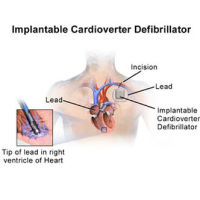According to research presented at EHRA EUROPACE – CARDIOSTIM 2015, cardiac device wearers should keep a safe distance from their smartphones in order to avoid any painful shocks or pauses in function.
Dr. Carsten Lennerz, first author and cardiology resident in the Clinic for Heart and Circulatory Diseases, German Heart Centre, Munich, Germany, explained that pacemakers can mistakenly detect electromagnetic interference (EMI) from smartphones as a cardiac signal. This could cause the pacemaker to stop working for a brief period of time which in turn could lead to a pause in the cardiac rhythm of the pacing dependent patient and may result in syncope. Similarly, for implantable cardioverter defibrillators (ICDs), the external signal mimics a life threatening ventricular tachyarrhythmia that could lead the ICD to deliver a painful shock to the patient.
Both device manufacturers and the FDA recommend a safe distance of 15 to 20 cm between pacemakers or ICDs and mobile phones. The new study evaluated whether the recommended safety distance was still applicable with the new smartphones available in the market and cardiac devices. The study included 308 patients with pacemakers and ICDs. They were exposed to the electromagnetic field of three common smartphones (Samsung Galaxy 3, Nokia Lumia, HTC One XL) which were placed on the skin directly above the cardiac device.
A standardised protocol of the calling process was used including ringing, talking and disconnecting and all the major networks including GSM, LTE and UMTS at the maximum transmission power and at 50 Hz were tested. Electrocardiograms (ECGs) were then recorded and checked for interference. In the 3400 tests performed, one out of 308 patients was affected by EMI caused by smartphones.
Lennerz said: 'Interference between smartphones and cardiac devices is uncommon but can occur so the current recommendations on keeping a safe distance should be upheld. Interestingly, the device influenced by EMI in our study was MRI compatible which shows that these devices are also susceptible.'
Prof. Christof Kolb, last author and head of the Department of Electrophysiology at the German Heart Centre, pointed out that since everyone these days uses a smartphone, there is a possibility of interference with a cardiac device. While patients with cardiac devices can still use mobile phones, it is advisable that they do not place it directly over the device and hold it to the ear opposite to the side of the device implant.
Another study on EMI was conducted to determine if high electric fields could also interfere with the normal functioning of cardiac devices and could result in the withholding of appropriate therapy or inappropriate shocks. The results indicated that pacemakers were immune to EMI up to 8.6 kV/m but if programmed to higher sensitivity levels or in unipolar mode, the EMI threshold decreased to 1.5 kV/m in some devices. ICDs were immune to EMI up to 2.9kV/m. No differences were found between left and right sided implants.
Dyrda said: 'There is no significant concern for patients with pacemakers programmed in the usual configuration (nominal settings, in bipolar mode). For the minority of patients with devices in unipolar mode or with very sensitive settings, counselling should be given at implantation or at medical follow-up.'
Patients with pacemaker or ICD are advised to either avoid crossing under high voltage power lines or stay in a stationary position underneath them. This advice does not concern distribution lines as the field they generate is very low.
Source: European Society of Cardiology
Image Credit: Irishhealth.com



























